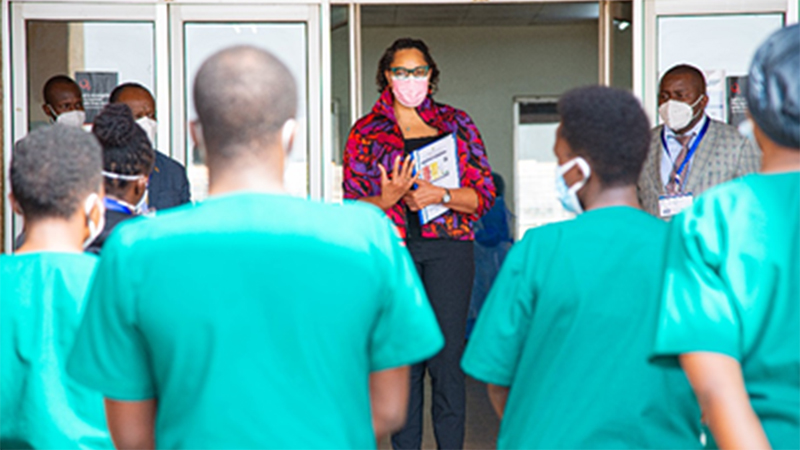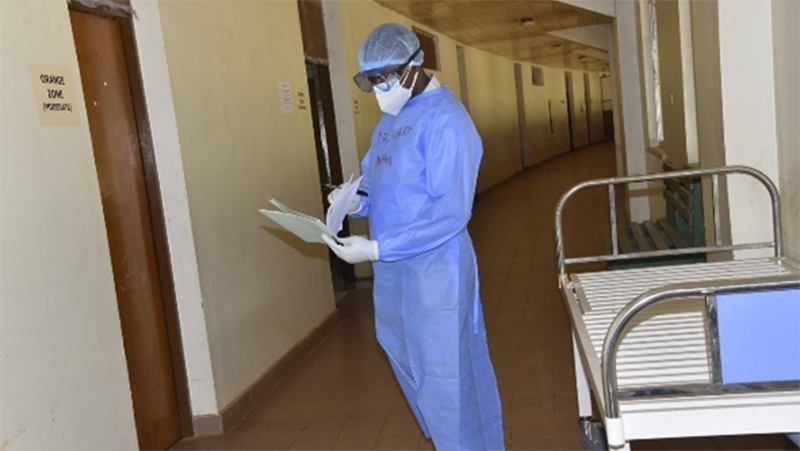Uganda Treats COVID-19 Patients in National Soccer Stadium
Summary
-
- COVID-19 patients get medical treatment at a field hospital set up in Uganda’s national soccer stadium.
- CDC leverages trust and relationships built over 30 years of working with Uganda’s Ministry of Health (MOH) and partners to support the COVID-19 response.
- Two doctors – one working for U.S. CDC and one embedded with Uganda’s MOH – trained medical staff how to triage COVID-19 patients.

A healthcare worker takes supplies to the COVID-19 treatment facility inside Namboole soccer stadium. Staff from the U.S. CDC office in Uganda and the Ministry of Health established a temporary field hospital inside Uganda’s biggest national sports arena. It was used to treat COVID-19 patients with mild or no symptoms to reduce pressure on local hospitals caring for more seriously ill patients. Photo by Christopher Lubega/U.S. Mission Uganda
Mandela National Stadium, home of Uganda’s national soccer team, is usually filled with tens of thousands of fans cheering for the home team.
COVID-19 put a stop to all sporting events in Uganda’s largest sports facility, which many locals still refer to by the original name “Namboole,” located on the outskirts of the capital, Kampala.
On March 13, 2020, two days after the World Health Organization declared COVID-19 a pandemic, Uganda’s Ministry of Health (MOH) issued measures to limit the spread of the disease. It also built a team with a variety of experts from MOH, the U.S. Centers for Disease Control and Prevention (CDC) in Uganda, and other partners to prepare for the pandemic response.
The U.S. CDC has worked in Uganda for 30 years and has collaborated with the MOH and partners to prevent, detect, control, and treat infectious diseases like HIV/AIDS, tuberculosis, and malaria.
“Uganda, more so than many other places, managed to delay, delay, delay COVID,” says Amy Boore, program director for the Division of Global Health Protection in the CDC Uganda office. “This was in large part due to their preparation and experience with outbreaks and all of the systems, programs, and people that were already in place,” she adds.
As COVID-19 cases started rising, and the scarce number of hospitals filled up, patients struggled to get care. And when COVID-19 spread to more underserved areas and more crowded communities, it was harder for people to isolate and protect their families from getting sick while at home.
Uganda’s MOH and Local CDC Team Search for COVID-19 Treatment Solutions
Boore was the incident manager for the U.S. Mission Uganda. She worked with the MOH and partners to find medical care for many of the patients who couldn’t find it.
As Uganda’s first COVID-19 wave began in April 2020, U.S. COVID funding was not yet available, but the CDC team took immediate action, says Boore. “We knew — whether or not it was in our lane — we had to step in.”
Annet Alenyo Ngabirano, MD, a Ugandan emergency care physician, joined the national COVID-19 task force in the Uganda MOH.
Alenyo said the task force was concerned that hospitals would soon be overflowing with patients. The task force members quickly discussed what they could do to prevent this from happening. They saw other countries turning convention centers and other large open spaces into field hospitals.
“Just reading about what was happening elsewhere and seeing our case numbers increase, it was clear that we needed to do something similar,” says Alenyo.
Namboole stadium was a natural fit. It had large rooms under the stadium seats, the buildings had ventilation systems in place, sanitation facilities were already installed, and of course, there was a large open area – the soccer field in the middle.
The COVID-19 task force was confident that an isolation ward could be set up in Namboole in a way that would allow for infections to be prevented and controlled.
Some adjustments were needed because the stadium wasn’t set up for people to stay for a long time.
The team from CDC and MOH had a long list of logistics to plan, many decisions to make, and key questions to answer, including:
- How would people access the Namboole treatment center?
- How would patient areas be separated from staff areas?
- Where would the main entrance and security points be?
CDC’s Michelle Adler, MD, was a member of the COVID-19 planning team and worked closely with Alenyo. Before COVID-19, Adler’s main job in Uganda was to manage the HIV care and treatment portfolio. “But once it was ‘all hands on deck’ for COVID-19, I became one of two deputies for the COVID response.”
Adler leveraged CDC relationships and partnerships to support the treatment facility and keep people safe. She recruited other doctors from CDC and the embassy’s medical unit to help. She also recruited the embassy to help set up the treatment center.
Adler even invited the U.S. ambassador to join the team and share her connections to help the Namboole project.
“We used the resources on the ground, the PEPFAR network, our connections with the international NGOs and the CDC expertise back in Atlanta to support Uganda’s COVID-19 response,” says Boore. “They all helped fill really critical gaps that happened during the pandemic that are really not normally within our scope of work.”
Namboole Stadium Becomes a COVID-19 Treatment Center
After roughly four months of planning and collaboration, the COVID-19 Treatment Unit (CTU) in the Namboole stadium opened in September 2020. This temporary field hospital was designed to treat COVID-19 patients with mild or no symptoms. Seriously ill patients who needed ventilators still had to go to a traditional hospital.
The facility was equipped with 1,200 beds and a limited amount of oxygen tanks.
Patients with mild symptoms could safely isolate from family members here. They stayed indoors at night and could spend time outdoors, including on the field, during the day.

COVID-19 patients with mild symptoms sit in the shade under the seats of the Namboole soccer stadium in Kampala, Uganda. The CDC-supported clinic was created to reduce pressure on local hospitals. The stadium provides plenty of space for patients to safely isolate outdoors, until it’s safe to go home to their families. Photo by Amy Boore/CDC Uganda

Two doctors check on patients staying at the COVID-19 treatment facility inside the Namboole soccer stadium outside Kampala, Uganda. This temporary clinic, set up by the Ministry of Health with U.S. CDC support, helped relieve pressure on hospitals caring for the most seriously ill COVID-19 patients. Photo by Abubaker Kazibwe/IDI.
The first COVID-19 wave peaked by the beginning of December 2020, and the field hospital stayed open until February 2021. A couple of months later, it was clear a second wave was on the horizon. The Namboole COVID-19 treatment center reopened to patients in May 2021. This time, the beds were ready and protocols were in place to coordinate patient care.
The peak of the second wave lasted from May through July 2021. When hospitals in the Kampala metro area were full, the Namboole clinic adapted. It was now a large-scale “first-stop” triage and treatment center for all COVID-19 patients.
Two Doctors – One From Uganda, One From the U.S. – Create a Triage System
During this second COVID-19 wave, the medical staff in the Namboole CTU began treating patients with moderate to severe symptoms, too.
But the clinic didn’t have enough staff or oxygen supply, and there was no triage system to make sure that the most critical patients were treated first.
“We had to develop very clear admission criteria for patients to the stadium,” Alenyo explains.
Adler and Alenyo trained staff on how to determine who should be admitted to Namboole and who needed to go to a traditional hospital. They also recognized the need to provide supplies for ambulances and train paramedics because at the time ambulance drivers only transported patients.
Boore notes, “there were only a handful of emergency physicians working in all of Uganda at the time. Namboole was fortunate to have one of them Dr. Alenyo.”
CDC used emergency funds to hire more nurses, provide more personal protective equipment, and get more medical supplies.
Keeping Morale High
In July 2021, U.S. Ambassador to Uganda Natalie E. Brown visited Namboole to learn more about the life-saving work that was being done under difficult circumstances and to motivate COVID-19 frontline workers.
It was “wildly morale boosting” for the staff, says Boore.
By August 2021, the Namboole clinic was also the place to get COVID-19 vaccines. The CTU closed in September. It opened one more time in December 2021 during Uganda’s third COVID-19 wave. The Namboole treatment facility closed in February 2022 and remains closed today.

U.S. Ambassador to Uganda Natalie E. Brown meets with healthcare workers who cared for patients at the CDC-supported COVID-19 treatment facility inside Uganda’s Namboole soccer stadium. Photo by Christopher Lubega/U.S. Mission Uganda

A doctor reviews a patient’s records before entering one of many patient rooms at the U.S. CDC-supported COVID-19 treatment unit set up inside Uganda’s Namboole soccer stadium. Photo by Abubaker Kazibwe/IDI
“The Namboole COVID-19 treatment facility is a great example of how CDC expertise in a country with minimum funding but with strong leadership and commitment from the government and the Ministry of health can make a tremendous difference,” says Boore.